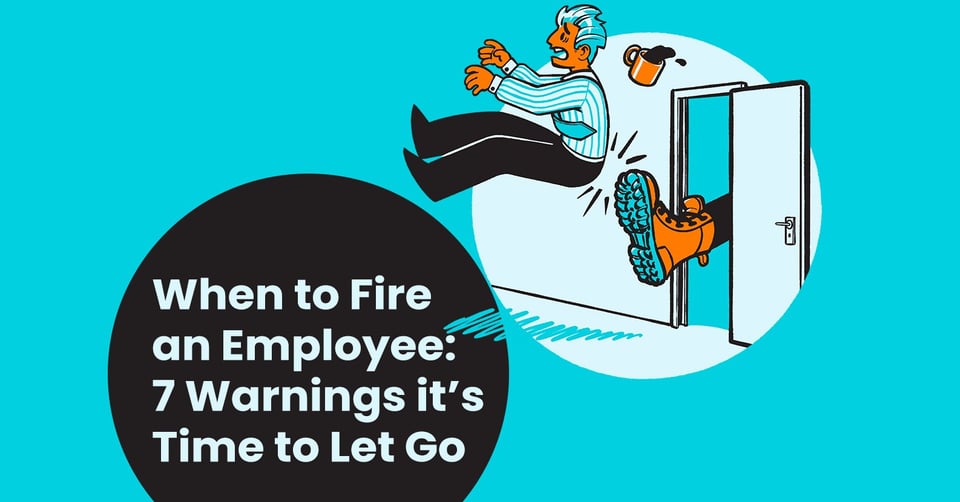
When someone on your team isn’t happy or performing to standards, you have two options: ignore the issue or get to the root of it.
If you ignore the issue, then you’ll never know when to fire someone. Instead, both you and they (and, likely, their team members) will become more and more frustrated. Bitterness will settle in and mix with a passive resignation on both your part and theirs. They’ll eventually leave after a long, ugly, downward slide.
Your other option is to get to the root of the issue now. Your choice leads you to three potential outcomes.
Source: Harvard Business Review (HBR)
If you dive into the root of the issue, you may 1: keep the team member, or 2: proactively cut ties. But remember, if you ignore the trouble, you’ll 3: eventually lose that person anyway.
Learning to decide and act is an essential business leadership skill. Here, we’ll discuss when to fire someone.
When to fire someone, indicator #1: You’ve done your part
The first way to know it’s time to terminate someone is when you’ve done all you can to help the person succeed.
To do this you must first find the root of your disappointment. Are your expectations off, or are they truly a drag on your operation? No one enters an employment agreement anticipating a future dismissal. So it’s natural — even healthy — to wonder, “Is it me? Or is this person failing to deliver?” For leaders thinking about when to fire someone, executive coach Kris Plachy has published a free me-or-them audit. It helps you see whether an employee's poor performance is changeable or set in stone since you don’t want your own blind spots to sabotage an already difficult decision.
Once you know it’s them, implement a recovery plan with clear outcomes. Start by seeing if they’re struggling with the most common four reasons employees flounder: it’s a bad fit, they’re disengaged, they’re dealing with internal relationship problems, or they’re having trouble in their personal life.
Then, take action. To develop and deploy your rescue plan, check out HBR’s recent guide on the topic.
If the struggling team member still doesn’t excel in their current role, consider cross-training them to learn and take up a new role. As you do, keep in mind this type of internal mobility should make up no more than 20%-30% of the folks in new positions. This limit ensures operations don’t suffer from too many roles with newbies.
If your person still fails to perform, at least you’ve done your part. At this point, waiting to fire the person even longer hurts your team, partner relationships, operations... and, worst of all, your finances.
When to fire someone, indicator #2: They hobble your finances
Underperformers cost your business — in more ways than one.
Most obviously, they cost your business in lost productivity.
Disengaged team members have 37% higher absenteeism, 49% more workplace accidents, and 60% more errors and defects.
As you know, productivity is every business’s main profitability lever. Companies with engaged workers enjoy 23% better profitability. Small businesses especially can’t handle one unproductive or counterproductive person because there are fewer people to cover for them.
Perhaps even more urgent is the possibility of an underperformer dragging down otherwise productive employees. An eye-opening 59% of workers say they’d be happy if their company’s business leaders would handle problematic co-workers. Let the problem fester, and you’ll start seeing turnover due to the culture that underperformers create.
Employers swallowed over $223 billion in the last five years from culture-driven turnover.
Source: SHRM's 2019 Culture Report
Remember, that’s the cost of those who leave. Disengaged employees who stay cost even more: workplace health experts at MHA National report that employers lose $450-$500 billion annually on disengaged workers.
So when deciding when to fire someone, remember, you’re also deciding when to stop the expensive spread of negativity.
Schedule a free call with an outsourced CFO from Ignite Spot to determine how much one employee can affect your business’s financial health. Our advisors are experts in analyzing how your operational productivity impacts your current financial footing and future growth.
And for now, ask yourself this: If your underperformer quit on their own, would their absence negatively — or positively — affect your business’s financial health?
When to fire someone, indicator #3: Logic supports your feeling
Deciding when to fire someone can be emotional and frustrating for both parties. It's best to be objective. Here’s how to know you're leading this fraught event with a cool head.
First, list your reasons on paper. Get your reasons down and vet them critically. Again, HBR has published a great progression to help you vet your own logic and admit any gaps.
Next, be sure you’re focused on the decision, not the conversation. The ire you feel toward the whole situation may simply be anxiety about the “we’re letting you go” conversation. The decision to fire them may not even be that difficult. But actually firing them is a different story altogether because of the obvious compassion you have for your employee. So parse the two events: the decision to dismiss and the actual conversation. Which one worries you the most? If it’s the conversation, then you’re reasoning is solid, and you’re ready to terminate this particular employee.
When to fire someone, indicator #4: The role has grown
When someone quits, it’s often because they outgrow the role. The reverse can happen: a position or company outgrows the person in it.
Executive consultants at Dando Advisors call this person the “Team Player” because their attitude and loyalty are not the problem. It’s especially important to work on developing this person and giving them another shot in a new role before letting them go.
Source: Dando Advisors
But then, beware the tendency to keep them around even if they don’t fit elsewhere.
These are often first hires or even family members. In the book “Success Is Never Final,” Marriott CEO Bill Marriott tells the story of his father and predecessor — J.W. Marriott — and his inability to fire his brother, Paul. “J.W. thought the only way his own health would improve was if he could remove the stress caused by having Paul at headquarters,” writes Bill. “Paul believed he should be an equal partner, and he was jealous of anyone else who won J.W.'s ear.”
In this case, an executive, early employee, and family member had failed to evolve as the position he occupied continued to grow and expand.
As you think though when to fire someone, again, give the person in question a chance to develop and move laterally before terminating. But once you see the role outgrow the person, it’s likely time to let them go.
When to fire someone, indicator #5: You wouldn’t hire them again
Should you keep an employee that you wouldn’t be excited to welcome aboard today? Frankly, no.
Hiring is risky by nature. Some people change over time, and others aren’t who you thought they were to begin with. Research from Checkster revealed that 78% of job hopefuls lie in the application and interview process. But that’s not the shocking part. What’s truly unnerving is that the same report found that 66% of the managers hiring these shysters willingly accept these falsehoods.
It’s hard to build a collaborative culture on this dicey team foundation — so why should you maintain it? The answer is that you shouldn’t. At some point, the true colors of both these charlatans and their compromising hiring managers emerge. When they do, you need to decide whether to get to the root of the issue or fire them.
Bottom line: if the person isn’t who you’d hire today to fill that role (even after investing in developing them), it’s an indication you may be ready to terminate.
When to fire someone, indicator #6: You’ve mitigated risk
Before dismissing an employee, you must be sure you’re doing it compliantly. If you’ve covered your bases, then that’s yet one more sign it’s time to terminate:
- • You’ve talked with your trusted legal advisor(s) about your reasons.
- • You know the termination would be for just cause.
- • You understand discrimination laws.
Think about the “reasons” you listed above — apply those to other people in the company. Would you fire them based on the same shortcomings?
And finally, have you documented all the necessary events in the deteriorating relationship and all the steps you took to restore the person in their role?
Attorney Scott M. Wich writes for the Society for Human Resource Management that documentation should be clear but succinct. “The words chosen for a termination memo can be a double-edged sword,” he notes.
“As a best practice, a termination memo should clearly state the reasons for termination. However, employers should take care not to pile on other reasons that are not motivating the discharge.”
When to fire someone, indicator #7: The feeling is somewhat mutual
The phrase “letting someone go” implies an employer is giving a worker what they truly (even if partially) want. Dan Lok, entrepreneur and author of the book Unlock It, says you should get creative to learn whether folks are truly team players.
Often, the employee is only vaguely aware they’re unhappy in their current role. But in hindsight, after being dismissed, they find they’ve been set free.
The web is full of “getting fired was the best thing for me” stories. These are not for you to communicate to your employee; that is not the kind of support they need right now. No, these stories are to help you feel confident in your choice to help someone — using the medium of dismissal. Workforce experts at TINYpulse list eight:
8 ways to know if an employee is unhappy:
- • Weakening productivity
- • Shorter workday hours
- • Fading involvement in non-work team activities
- • Cares less about co-workers (usually the number-one driver of employee happiness)
- • Stops contributing ideas
- • Their negativity affects the atmosphere
- • Other team members mention it’s a problem
- • Customers make comments about the disgruntled team member
Don’t wait for all these signals to arise. Get to the root of the issue immediately. And if they’re not happy, set them free.
Want to scale? Learn when (and how) to fire people well
People focus on hiring and tend to neglect termination, which is an equally crucial leadership skill. Ignoring this artful science will hold you back.
“The best leaders are just as good at removing people from jobs for which they’re unsuited as they are at putting rising stars into the right positions,” writes Joel Peterson, chairman of JetBlue Airways. And we agree. Managing your workforce — both coming and going — is key to a profitable future.
For an analysis of how to optimize your workforce for growth, schedule a free 30-minute phone call with one of Ignite Spot’s virtual CFOs today.













.png)


